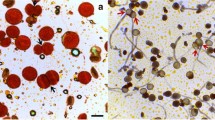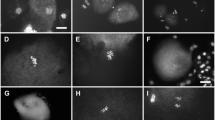Abstract
Pollen stainability over two years and microsporogenesis were investigated in seven dihaploids extracted fromSolanum tuberosum tetraploids (AVRDC-1287.19, Conchita, Merrimack and W231). Two dihaploids proved to be male-sterile and male gamete abortion is likely to be post-meiotic because a regular meiosis occurred. The other dihaploids proved to be partially male-fertile and 2n pollen producers, as well. Almost all clones showed predominantly the formation of parallel spindles. Correlations estimated between the observed abnormalities in spindle orientation and the meiotic products evidenced a high correlation between parallel/fused spindles and dyads. The dihaploids were also used as parents in crosses with tetraploids. One berry with 44 seeds was obtained from dihaploid AVI 24 used as pollen parent in 4x × 2x crosses. After 2x × 4x crosses, three dihaploids including the two male-sterile were found to be 2n egg producers.
The formation of 2n gametes inS. tuberosum dihaploids is discussed in relation to a direct use of dihaploids in sexual polyploidization schemes to combine useful traits in a superior genotype at 4x level.
Similar content being viewed by others
Literature cited
Barone, A., D. Carputo, G. La Rotonda, and L. Frusciante. 1997. Discrepancy between spindle anomalies and 2n pollen production inSolanum interspecific hybrids. Am Potato J 74: 399–403.
Carputo, D., T. Cardi, L. Frusciante, and S.J. Peloquin. 1995. Male fertility and cytology of triploid hybrids between tetraploidSolanum commersonii (2n=4x=48, 2EBN) and Phureja-Tuberosum haploid hybrids (2n=2x=24, 2EBN). Euphytica 83: 123–129.
Carputo, D., M. Speggiorin, P. Garreffa, A. Raio, and L.M. Monti. 1996. Screening for resistance to tuber soft rot and blackleg in diploidSolanum species andS. tuberosum, haploids. J Genet Breed 50: 221–226.
Carrol, C.P. and R.J. Low. 1976.Tuberosum dihaploids. Potato Res 19: 109–121.
Conicella, C., G. Genualdo, A. Errico, L. Frusciante, and L.M. Monti. 1996. Meiotic restitution mechanisms and 2n pollen formation in aSolanum tuberosum dihaploid and in dihaploid × wild species hybrids. Plant Breed 115: 157–161.
Genualdo, G., A. Errico, A. Tiezzi, and C. Conicella 1998. α-tubulin and F-actin distribution during microsporogenesis in a2n pollen producer ofSolanum. Genome 41: 636–641
Hanneman, R.E. Jr. and S.J. Peloquin. 1981. Genetic-cytoplasmic male sterility in progeny of 4x-2x crosses in cultivated potatoes. Theor Appl Genet 59: 53–55.
Hermundstad, S.A. and S.J. Peloquin. 1985. Male fertility and2n pollen production in haploid-wild species hybrids. Am Potato J 62: 479–487.
Iwanaga, M. and S.J. Peloquin. 1982. Origin and evolution of cultivated tetraploid potatoes via 2n gametes. Theor Appl Genet 61: 161–169
McHale, N.A. 1983. Environmental induction of high frequency 2n pollen formation in diploidSolanum. Can J Genet Cytol 25: 609–615.
Mok, D.W.S. and S.J. Peloquin. 1975. Three mechanisms of 2n pollen formation in diploid potatoes. Can J Genet Cytol 17: 217–225
Nilmalgoda, K.W.S.D. 1994. Male sterility in haploids (2n=2x=24) of tetraploid (2n=2x=48) potato. PhD thesis. University of Wisconsin-Madison.
Ortiz, R., M. Iwanaga, and S.J. Peloquin. 1993. Male sterility and 2n pollen in 4x progenies derived from 4x × 2x and 4x × 4x crosses in potatoes. Potato Res 36: 227–236.
Ortiz, R. and S.J. Peloquin. 1994. Use of 24-chromosome potatoes (diploids and dihaploids) for genetical analysis.In: Bradshaw J.E. and Mackay G.R. (Eds) “Potato Genetics” pp 133–154. CAB International.
Parrot, W.A. and R.R. Smith. 1986. Recurrent selection for 2n pollen formation in red clover. Crop Sci 26: 1132–1135.
Quinn, A.A., D.W.S. Mok, and S.J. Peloquin. 1974. Distribution and significance of diplandroids among the diploidSolanums. Am Potato J 51: 16–21.
Ramanna, M.S. 1979. A re-examination of the mechanisms of 2n gamete formation in potato and its implications for breeding. Euphytica 28: 539–561.
Ross, R.W., S.J. Peloquin, and R.W. Hougas. 1964. Fertility of hybrids fromSolanum phureja and haploidS. tuberosum matings. Eur Potato J 7: 81–89.
Tai, G.C.C. 1994. Use of 2n gametes.In: Bradshaw J.E. and Mackay G.R. (Eds) “Potato Genetics” pp 109–132. CAB International.
Veilleux, R.E., N.A. Mc Hale, and F.I. Lauer. 1982. 2n gametes in diploidSolanum: frequency and types of spindle abnormalities. Can J Genet Cytol 24: 301–314.
Werner, J.E. and S.J. Peloquin. 1987. Frequency and mechanisms of 2n egg formation in haploidTuberosum-wild species F1 hybrids. Am Potato J 64: 641–654.
Author information
Authors and Affiliations
Additional information
Contribution no. 84 from CNR-IMOF, Research Institute for Vegetable and Ornamental Plant Breeding.
Rights and permissions
About this article
Cite this article
Alfano, F., Cammareri, M., Errico, A. et al. 2n gametes inSolanum tuberosum dihaploids. Am. J. Pot Res 76, 281–285 (1999). https://doi.org/10.1007/BF02853626
Accepted:
Issue Date:
DOI: https://doi.org/10.1007/BF02853626




